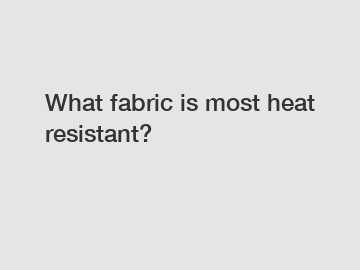What fabric is most heat resistant?
HEBEI CANGCHEN are exported all over the world and different industries with quality first. Our belief is to provide our customers with more and better high value-added products. Let's create a better future together.
When it comes to choosing fabrics for various applications, one of the key factors to consider is heat resistance. Whether you're looking for a material to use in protective clothing, upholstery, or industrial applications, it's important to select a fabric that can withstand high temperatures without compromising its integrity.
There are several factors that determine a fabric's heat resistance, including its composition, density, and treatment. Some fabrics are naturally more heat resistant than others, while others can be treated to improve their heat resistance properties.

One of the most heat-resistant fabrics available today is Kevlar. Kevlar is a synthetic fiber known for its high tensile strength, durability, and heat resistance. It is commonly used in protective clothing, such as firefighter gear, bulletproof vests, and racing suits, due to its ability to withstand extreme temperatures without melting or degrading.
Another highly heat-resistant fabric is Nomex. Nomex is a flame-resistant meta-aramid material that is widely used in industries where workers are exposed to high temperatures, such as firefighting, military, and aerospace. It has excellent heat resistance properties, making it a popular choice for protective clothing and equipment.
In addition to Kevlar and Nomex, other heat-resistant fabrics include fiberglass, silicone-coated fabrics, and PBI (polybenzimidazole) fiber. These materials are commonly used in industrial applications where high temperatures are present, such as insulation, gaskets, and seals.
When choosing a heat-resistant fabric, it's important to consider the specific requirements of your application. Factors such as the temperature range, exposure time, and mechanical stress can all impact the performance of the fabric. It's also important to consider other properties, such as abrasion resistance, flexibility, and chemical resistance, to ensure that the fabric will meet your needs.
In addition to selecting the right fabric, proper care and maintenance are also essential to ensure the fabric's heat resistance properties are maintained over time. Regular cleaning, inspection, and testing can help identify any potential issues or damage that may impact the fabric's performance.
Overall, the most heat-resistant fabric will depend on the specific requirements of your application. However, fabrics such as Kevlar, Nomex, fiberglass, silicone-coated fabrics, and PBI fiber are all excellent options for applications where heat resistance is critical.
In conclusion, when selecting a fabric for applications that require heat resistance, it's important to choose a material that can withstand high temperatures without compromising its integrity. There are several heat-resistant fabrics available, including Kevlar, Nomex, fiberglass, silicone-coated fabrics, and PBI fiber, each with unique properties and applications. By considering the specific requirements of your application and selecting the right fabric, you can ensure the safety and performance of your products or equipment in high-temperature environments.
Are you interested in learning more about Sic Filter? Contact us today to secure an expert consultation!



